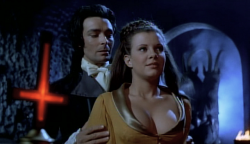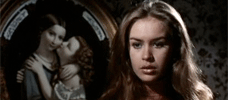Reviews
Vampiros Lesbos
Jesus Franco
West Germany / Spain, 1971
Credits
Review by Anna Bak-Kvapil
Posted on 18 February 2011
Source Synapse DVD
Categories Lesbian Vampires
Some say Jess Franco is a hack. Some say he’s a genius. More simply, he’s a man who uses movies exclusively as a tool to explore his own perversions. His films have their negative aspects—glassy-eyed actors, shaky camera work, cheap sets and incomprehensible scripts. But give in to Franco’s lack of logic and accept technical ineptitude as part of the general ambience, and his work starts to cohere. Franco’s vast body of films knit together into one long private fantasy, comprised of equal parts glamour, sleaze and compulsion.
Franco was a filmmaker originally promoted as part of the 60’s Euro-erotica explosion. In a trailer for his 1968 film Succubus, the narrator announces: “first there was La Dolce Vita, then Boccaccio ‘70, and now, Succubus…” Rather than rising through the ranks to keep company with Fellini and Visconti, however, Franco has continued to churn out a distressing amount of low budget soft-core fantasias (recent titles include Killer Barbys vs. Dracula and Snakewoman). Vampires are an inescapable presence in his films, and just a year before the 1971 Vampyros Lesbos (or, alternately, Vampiros Lesbos, among other titles), Franco had made Count Dracula (1970) with Christopher Lee, Klaus Kinski, and his muse, Soledad Miranda.
Recounting the plot of Vampyros Lesbos makes the film seem both more comprehensible and more confusing than it actually is. Plush blond Linda Westinghouse, an employee of law firm “Simpson & Simpson” must travel to the fictional Anatolian island of Kadidados to transfer a deed belonging to the late Count Dracula over to the mysterious Countess Carody. Once on the island, the Countess seduces Linda with a nude sunbathing session and a drugged glass of wine, and after some tender kisses, proceeds to feast on her blood. Linda is found wandering on the beach with a blank memory, placed in an asylum, and retrieved by her boyfriend. But under the influence of hypnosis, she finds her way back to Carody, who indoctrinates her into the ways of the vampire, which also involves tender kisses. A Van Helsing-type psychiatrist tries to explain what is going on to Linda, but is eliminated by Carody’s henchman before he has a chance to accomplish anything.
Meanwhile another female victim writhes around in a mental institution, and Carody passes time as a performer in an erotic nightclub act. At one point the plot segues into an odd vignette about a sadistic porter, played by Jess Franco, who tortures and murders women (Linda dispatches him with a hacksaw to the neck). Shots of a white scorpion, a moth caught in a net, and a red kite appear over and over, appearing to represent predatory instincts, weakness and erotic longing. The film functions on dream logic and dream symbolism, and comes aggravatingly close to almost making sense by the end.
Zooms dominate Vampyros Lesbos. Through the constant motion of zooming in and out, the camera adopts a penetrating rhythm, swimming through the celluloid. But beyond endowing the film with a liquescent atmosphere, it’s a clever money saving technique. Apparently without a dolly, and with no time to set up close-ups and establishing shots, Franco uses the zoom to cut corners, and makes his film that much artier, although fuzzy focus in many shots seems not quite intentional.
Vampyros Lesbos loses some of its gritty charm on a wide screen TV. It begs to be seen the original context of a Times Square grindhouse theater with an audience of pervs and junkies, or a through a haze of hashish at a liberal arts college revival house. The score is a trip in itself, composed by Manfred Hubler and Siegfried Schwab who create a psychedelic soundscape that engulfs the film. What sounds like a sitar-backed air traffic controller speaking in Arabic erupts alarmingly at dramatic moments. During sex scenes, Jane Birkin “Je t’aime” style moans overlap with Marvin Gaye-esque “aw yeahs ” over jazz organs and a dense brass section of trumpets and trombones. Free-form jazz odysseys and lesbian vampires prove to be an ideal match.
With plenty of naked ladies, frequent orgasmic gasping, and a money shot of Soledad Miranda’s bloody eye socket, Franco delivers roughly what his audience expects. But two gentle love scenes, plus a tame nightclub act add up to a rather un-exploitative exploitation flick. And with the exception of some ornate candelabras, and an empty castle on a hill, Vampyros Lesbos dispenses with Victorian atmospherics and the more cumbersome rules of vampire mythology. Slaying is made stylish, a stake through the heart exchanged for an ice pick in the eye. Countess Carody’s beach house, complete with large pool, has walls of windows to let in the sunlight.
And Carody, the woman who “made Dracula’s life worth living” must be one of the most trend-conscious vampiresses in film history. She’s groovy, not goth, her house a model of Euro-mod chic, with its Saarinen table, Arco lamp, and crimson red sectional sofa. A near iconic shot introduces her, a zoom zeroing in on her black bug eye sunglasses as she lounges in a white bikini on a wicker chaise. Unlike her pallid ancestors, the Countess has a deep tan and nonthreatening incisors. When she invites Linda to go skinny dipping, she may be the first vampire to say “It’s fun to be naked in the sand.” Surrounded by B-movie vixens, Soledad Miranda’s vampire queen stands apart. Inscrutably dignified, her presence transcends the film. She exudes the potential of a major star, but by the time Vampyros Lesbos was released, she had died in a car accident on a Lisbon highway.
Since the lustful Countess Zaleska in the Univeral horror classic Dracula’s Daughter (1936), vampiresses have preyed on beautiful women in the movies. Typically turned into vampires against their will, they survive after Dracula’s death to suffer in conflicted isolation. In a rare moment of narrative clarity in Vampyros Lesbos, Countess Carody lies on a dark red divan, staring up at the ceiling. As though speaking to a psychoanalyst, she tells the story of how Dracula saved her as a young girl from marauding soldiers, but also drained her blood. She says, “Men still disgust me, I hate them all.” Trying to attribute deep meaning to Vampyros Lesbos may be an exercise in futility, but the character of Countess Carody does add a wispy layer to the lesbian vampire myth. She is a victim, a devout worshiper of the female body, and a bohemian babe who wants nothing to do with men. With her fashionable wardrobe and subtle seduction techniques, Carody paves the way for the mysterious lady vampires of The Hunger and Nadja, bequeathing to female bloodsuckers a fresh element of psychological complexity, and a much more au courant style.
More Lesbian Vampires
-

Rape of the Vampire
1968 -

The Vampire Lovers
1970 -

Lust for a Vampire
1971 -

Twins of Evil
1971 -

Vampyros Lesbos
1971 -

Daughters of Darkness
1971 -

The Blood Spattered Bride
1972 -

Vampyres
1974
We don’t do comments anymore, but you may contact us here or find us on Twitter or Facebook.



